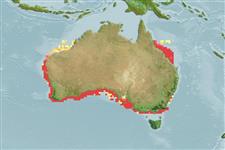Teleostei (teleosts) >
Clupeiformes (Herrings) >
Spratelloididae (Small round herrings)
Etymology: Spratelloides: Old German, sprotte (1611) = a small fish, Clupea sp. + Greek, suffix, oides = similar to (Ref. 45335).
More on author: Ogilby.
Issue
The species in the genera Spratelloides Bleeker, 1851 and Jenkinsia Jordan & Evermann, 1896 should most probably be assigned to a separated family from Clupeidae and Dussumieriidae (Lavoué, pers. comm., July 2013). See a preliminary analysis in Lavoué et al. (2013: Ref. 93878).
Environment: milieu / climate zone / depth range / distribution range
Ecology
Marine; brackish; pelagic-neritic; depth range 0 - 50 m (Ref. 188). Subtropical; 17°S - 39°S, 112°E - 152°E (Ref. 188)
Eastern Indian Ocean: southern Australia, from Dampier Archipelago, Western Australia to southern Queensland, including Tasmania.
Size / Weight / Age
Maturity: Lm ? range ? - ? cm
Max length : 12.0 cm SL male/unsexed; (Ref. 33617)
Dorsal spines (total): 0; Dorsal soft rays (total): 10 - 14; Anal spines: 0; Anal soft rays: 9 - 14; Vertebrae: 46 - 47. No teeth on maxilla, triangular premaxillae, 2 supra-maxillae, second supra-maxilla symmetrical; scale striae meeting at center; toothed posterior margin to scales, pre-dorsal scales 13 to 16; W-shaped pelvic scute.
Usually inshore schooling fishes (Ref. 188). Occurs in midwater in bays, inlets and coastal waters (Ref. 9563). Also often found around shallow offshore reefs (Ref. 33617).
Life cycle and mating behavior
Maturity | Reproduction | Spawning | Eggs | Fecundity | Larvae
Whitehead, P.J.P., 1985. FAO Species Catalogue. Vol. 7. Clupeoid fishes of the world (suborder Clupeoidei). An annotated and illustrated catalogue of the herrings, sardines, pilchards, sprats, shads, anchovies and wolf-herrings. FAO Fish. Synop. 125(7/1):1-303. Rome: FAO. (Ref. 188)
IUCN Red List Status (Ref. 130435: Version 2024-2)
Threat to humans
Harmless
Human uses
Fisheries: minor commercial; bait: usually
Tools
Special reports
Download XML
Internet sources
Estimates based on models
Preferred temperature (Ref.
123201): 15.5 - 27, mean 22.9 °C (based on 224 cells).
Phylogenetic diversity index (Ref.
82804): PD
50 = 0.5625 [Uniqueness, from 0.5 = low to 2.0 = high].
Bayesian length-weight: a=0.00389 (0.00180 - 0.00842), b=3.12 (2.94 - 3.30), in cm total length, based on all LWR estimates for this body shape (Ref.
93245).
Trophic level (Ref.
69278): 3.4 ±0.45 se; based on food items.
Resilience (Ref.
120179): High, minimum population doubling time less than 15 months (Preliminary K or Fecundity.).
Fishing Vulnerability (Ref.
59153): Low vulnerability (10 of 100).
Nutrients (Ref.
124155): Calcium = 231 [95, 789] mg/100g; Iron = 2.85 [1.02, 8.15] mg/100g; Protein = 20 [18, 22] %; Omega3 = 0.379 [0.164, 0.869] g/100g; Selenium = 32.5 [9.6, 98.8] μg/100g; VitaminA = 21 [5, 86] μg/100g; Zinc = 2 [1, 4] mg/100g (wet weight); based on
nutrient studies.
